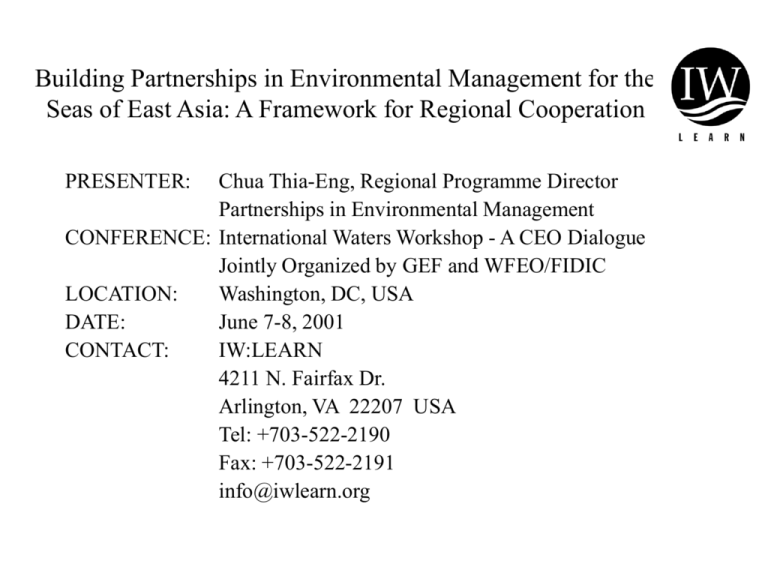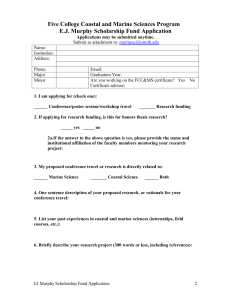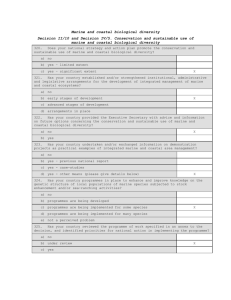Building Partnerships in Environmental Management
advertisement

Building Partnerships in Environmental Management for the Seas of East Asia: A Framework for Regional Cooperation PRESENTER: Chua Thia-Eng, Regional Programme Director Partnerships in Environmental Management CONFERENCE: International Waters Workshop - A CEO Dialogue Jointly Organized by GEF and WFEO/FIDIC LOCATION: Washington, DC, USA DATE: June 7-8, 2001 CONTACT: IW:LEARN 4211 N. Fairfax Dr. Arlington, VA 22207 USA Tel: +703-522-2190 Fax: +703-522-2191 info@iwlearn.org Building Partnerships in Environmental Management for the Seas of East Asia: A Framework for Regional Cooperation Chua Thia-Eng The East Asian Seas Coastline: 234,000 km Sea area: 7 million km2 Total population: 1.9 billion Coastal population: 522 million 213 million are poor in China; 65 million in the rest of EAS Uses of the EAS: • food supply • livelihood • medicine • energy • minerals • transport • recreation PEMSEA - multi-country, multi-sector collaboration and partnerships shared vision strategy program of actions INITIAL DRAFT as of 25 May 2001. Do not cite. ENVIRONMENTAL STRATEGY for the Seas of East Asia A Strategic Approach to Achieving Shared Vision Values • Ecological Shared Vision • Aesthetic • Historical and cultural • Recreation Threats • Development • Habitat conversion • Over-exploitation • Land-based pollution sources • Oil and chemical pollution • Destructive fishing practices • Invasive species Strategies Action Programs Sustain Action Programs Preserve Action Programs Protect Action Programs Develop Action Programs Implement Action Programs Communicate Action Programs • Sea level rise • Climate change • Resource use conflicts • Uncontrolled development • Erosion/Siltation and sedimentation • Trade in endangered species STRATEGIC ACTION STATEMENT The East Asian countries shall: Ensure Sustainable use of coastal and marine resources. Preserve species and areas of the coastal and marine environment that are pristine or are of ecological, social or cultural significance. Protect ecosystems, human health and society from risks occurring as a consequence of human activities. Develop economic activities in the coastal and marine environment that contribute to economic prosperity and social well-being while safeguarding ecological values. Implement international instruments relevant to management of the coastal and marine environment. Communicate with stakeholders to raise public awareness, strengthen multisectoral participation and obtain scientific support for the sustainable development of the coastal and marine environment. ENVIRONMENTAL STRATEGY FOR THE SEAS OF EAST ASIA General Principles The environment of the Seas of East Asia should be managed to ensure preservation of the ecosystems and the well-being and dignity of the people of the region. The right to development must be fulfilled so as to equitably meet development and environmental needs of present and future generations. (Agenda 21, Principle 3) Management of coastal and marine resources and the activities affecting them should respect natural processes and systems. Beneficial uses of the resources shall be encouraged and adverse uses avoided or minimized. Basic linkages between sustainable management of coastal and marine resources, poverty alleviation, and protection of the marine environment should be recognized (APEC Action Plan) ENVIRONMENTAL STRATEGY FOR THE SEAS OF EAST ASIA General Principles The rights of all sectors of society shall be respected and the role of civil society recognized. The precautionary approach shall be widely applied. Where there are threats of serious irreversible damage, lack of full scientific certainty should not be used as a reason for postponing cost-effective measures to prevent environmental degradation. (Principle 15, Agenda 21) Activities within one State should not cause damage by pollution to other States and their environment. (UNCLOS, Art. 194(2)) The interrelationship between conservation and socioeconomic development implies both that conservation is necessary to ensure sustainability of development, and that socioeconomic development is necessary for the achievement of conservation on a lasting basis. (ASEAN Agreement on the Conservation of Nature and Natural Resources, 1985) Supporting Implementation 1. Enabling local governments to effectively manage coastal and marine environment and their natural resources; 2. Promoting cross boundary, multi-sector, multiagency cooperation in managing subregional sea areas and marine pollution hotspots; 3. Developing management related methodologies, techniques, working models, and standards to strengthen practical efforts in the field; 4. Providing policy support and scientific advise to the decision-makers; Supporting Implementation 5. Identifying and demonstrating the synergies and linkages between related international environmental instruments and facilitating their integrated implementation; 6. Creating environmental investment opportunities and integrating environment investment as an integral part of economic development programmes; 7. Strengthening communication amongst stakeholders, partners and the general public Supporting Implementation 1 Enabling local governments to effectively manage coastal and marine environment and their natural resources Capacity Building Internships Regional Task Force Demonstration Sites Integrated Coastal Management ICM Demonstration and Parallel Sites Supporting Implementation 2 Promoting cross boundary, multi-sector, multi-agency cooperation in managing subregional sea areas and marine pollution hotspots Marine Pollution Hot Spots Bohai Sea Institutional Arrangements Manila Bay Risk Assessment Response Environmental Monitoring Capacity Building Compensation/ Restoration Gulf of Thailand Malacca Straits Supporting Implementation 3 Developing management related methodologies,techniques, working models, and standards to strengthen practical efforts in the field Risk assessment/Risk management Integrated Coastal Management Integrated Information Management System (IIMS) Sea Use Zoning Schemes Public-Private Sector Partnerships Marine Electronic Highway (MEH) ISO 14001 for Local Government Products and Services: IIMS operational structure U S E R S Modelling/ forecasting software • • • • Environmental assessment Planning Management Monitoring IIMS Products Remote sensing Baseline information Thematic maps GIS Environmental Database IIMS central node IIMS ICM/ hot spot nodes environmental monitoring Marine Electronic Highway Functional Diagram GPS in situ obs. VTIS Data interface Real-time Envt’l Info radar Applications Module Goals oil spill ENCs 3D circulation model - hydrodynamics - s, T, d t plus 3D ecology model - plankton - nutrients - sediments - contaminants search and rescue tanker drift tsunami / surge wave forecasting tides and currents emergency response electronic navigation traffic management fishery forecasts ocean productivity hazardous plankton forecasts effluent dispersion contaminant fate and effects resource management and intervention environmental protection Supporting Implementation 4 Providing policy support and scientific advice to the decision-makers Integrated coastal management the application of risk assessment for environmental management application of public sector – private sector partnership for environmental clean-up ecological carrying capacity trade on marine endangered species trade-offs between economic development and environmental protection Supporting Implementation 5 Identifying and demonstrating the synergies and linkages between related international environmental instruments and facilitating their integrated implementation GEF International Conventions 21 ICM and Agenda International waters • UNCLOS • land-water use • IMO • UNEP Agenda 21, Chapter 17 Integrated management and sustainable development of coastal and marine areas • contaminants • transboundary Integrated Coastal Management Sustainable human development • poverty • environment • employment • women • integrated policy multiple use • preventive and precautionary principles • value changes • stakeholders consultation and participation UNDP Global Programme of Actions on land-based • issues identification pollution (1995) • national level • regional cooperation • international cooperation • approaches and assessment • priorities • integrated planning and management • strategies and action • financing mechanism Supporting Implementation 6 Creating environmental investment opportunities and integrating environmental investment as an integral part of economic development programmes Stimulated by environmental threats Public health Ecosystem health Societal health Policy and management framework ICM framework Risk management framework Coastal and marine policy Public awareness National and local capacity Supporting Implementation 7 Strengthening communication and environmental education amongst stakeholders, partners and the general public forming partnerships with NGOs, media and religious groups youth and women groups summer camp communication plans videos, comics, public clean-up campaigns Environment Investment Opportunities in the EAS Region Vast coastal population Rapid coastal urbanization Fast economic growth Globalization Environment Investment Opportunities in the EAS Region Improved standard of living Green movement High remedial cost Environment Investment Opportunities in the EAS Region Decentralization to strengthen local governance National coastal and marine policy Specific national target/direction China: 40% reduction in pollution load under its 10th plan Indonesia: 50% of coastal provinces implementing ICM Philippines: national coastal management plan targets 1000 coastal municipalities A New Paradigm in Environmental Management Sustainable development = environmental protection + economic development Partnerships A New Paradigm in Environmental Management Holistic, coordinated and integrated in planning and management Ecosystem management Stakeholders involvement A New Paradigm in Environmental Management Use local governments to address environmental problems Use the power of science and information technology Use the resources and expertise of the private sector Use the power of civil society Partnership between public and private sector Create investment environment Identify priority environmental facilities and services Package investment opportunities Promote investment opportunities Bring the two parties together into partnership Advantages of PEMSEA’s Approach 1. Management framework at each PEMSEA site 2. Reduced political and investment risks of the investors 3. Benefits of PPP process to the private investors 4. Benefits of PPP process to the public sector Public-Private Sector Partnerships: EAS version Identifying investment opportunities at ICM sites and RA/RM ‘hot spot’ locations Technical and economic pre-feasibility Defining mechanisms to catalyze, promote and advance environmental investments Round table meetings with investors, partners and stakeholders Investment processes Technologies and Services Synthesizing policy/regulatory issues to create a climate conducive to environmental investments Public-Private Sector Partnerships in Batangas, Philippines CORPORATE STRUCTURE Philippines Batangas Province (34 municipalities) New Zealand McConnell International Ltd. United Environmental Ltd. Batangas Waste Inc. SOE Waikato NZ Waste Managers Ltd. Batangas Utilities Development Inc. Perry Waste Services Ltd. Sustainable Regional Mechanism International Frameworks for Coastal & Marine Management Int’l Conventions Int’l Action Plans Regional Implementing Mechanism Participating Countries in the Region Products & Services Technical Assistance Int’l, Regional Org./ Donors Institutional Arrangements Marine Environment Resource Foundation Envt’l Envt’l Grants InvestInvestand ment ment Donations Center Fund Private Sector Products & Services Financial Arrangement for Marine Environment Resource Foundation Products and Services Grants and Donations Environment Investment Fund (Investment Center) Thank You






